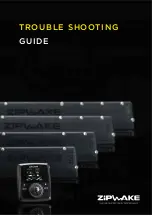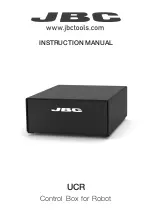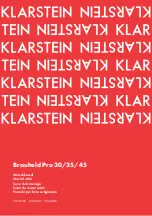
63
THE METHOD FOR LOW CARBONATED BEERS
When you brew beers at a very low carbonation level, another
technique is required. This is because the pressure is so low,
we cannot release gas from the vessel via the VPRV lower than
atmospheric pressure (0 bar) and so the first two methods des-
cribed above cannot work. For example, if you’re making an
English Ale at 5°C and want a carbon dioxide content of 3 g/l,
you only need 0.12 bar pressure in the vessel, which is very low.
So you cannot release 0.25-0.5 bar out of the vessel as described
in the first method when making well carbonated beers.
In this case you need to brew with the VPRV set at about 0.25
bar above the level of carbonation you want (to allow for the
drop in pressure when the cooling is put on) and set the gas
cylinder at 0.25-0.5 bar above that (to create the pressure differ-
ential). Then clarify as per normal and the gas bottle pressure
will force the clarification agent in the beer. The pressure will
increase in the vessel and it may release itself out of the VPRV.
When you’ve finished clarifying, you then should release pressure
out of the VPRV to the level you want in the final beer.
You will clarify a second time using the same principle.
Once you have finished the second clarification, release the
increased gas in the vessel again to the pressure (and therefore
carbonation level) you want. Then wind the VPRV down to its
closed position (clockwise). Then after this, you will finally set
the gas cylinder at the same pressure which is your chosen
dispense pressure, and open the 3-way valve to the vessel.
When you dump the sediment bottle after 36 hours the
beverage will be at the correct pressure and carbonation.
The difference with this method is that you cannot set the
gas cylinder at the pressure you want in the final beer during
dispense until after you have clarified. With higher carbonated
beers as described in the first two methods above, you can
set the gas cylinder pressure at the beginning of the process
and not change it and use the VPRV to make the pressure
differential by releasing pressure from the tank.
In either case the principle is the same in that a pressure
differential of 0.25 -0.5 bar is required between the vessel (at
the lower pressure) and the gas cylinder (at the higher pressure)
in order to force the clarification agent in when the 3-way valve
is opened to the clarification pot.
RINSING THE POT
It is important to rinse the pot after each clarification and
also bubble that into the beverage in order to clear the line of
clarification agent.
The clarification agent can form little solid lumps if left over
time and this can get stuck in the one-way valve under the pot.
So you MUST rinse the line each time.
Otherwise beverage will start to come back up the pot and
create problems.
You need to hear the bubbling for only 1 second as that means
all the water has been rinsed through the one-way valve and the
clarification line and into the beverage.
If it does block and beverage is seen filling the pot over time,
the panel can be taken off the tower and the one-way removed,
as long as the vessel isn’t under pressure. The solids can be
rinsed, blown or tapped out and the one-way put back.
To remove the one-way valve you need to push the push lock
fitting while pulling the tubing out. You must ensure the lines
are pushed hard back into the ends of the one-way valve when
you replace it. You must also ensure the one-way is put back on
in the correct direction so fluid can flow from pot to vessel.
DIFFICULT YEAST
Some yeast are very difficult to clear and may require extra
clarification. In this case you should remove the sediment bottle
and dump the sediment from the first two clarifications. Fill up
the sediment bottle with foam again and clarify a third time with
30ml as per the instructions for the first clarification.
The yeast we are using all clear very easily except for T-58 &
WB-06 which can sometimes be stubborn. However Belgian
Ales and wheat beers can be a little hazy and still true to style
so if they don't quite clear to what you experience with the other
yeast, perhaps enjoy it a little hazier than you would the other beers.
Other yeast bought through other suppliers may of course be
used in a WilliamsWarn and you will need to see how they react
to our agent. We’d assume 80% of brewing yeasts will clear.
You can also try other finings agents through the pot if our agent
doesn’t seem to work for the beer you are making.
IMPORTANT SAFETY INSTRUCTION
Only use liquids in the clarification pot. The use of solids or
liquids with particles may cause blockage or fault in the one-
way valve that is under the clarification pot. Always strain any
clarification agent or flavours added into the pot. Water can be
added without straining it.
Содержание BrewMaster
Страница 3: ...PART ONE YOUR PERSONAL BREWERY...
Страница 14: ...PART TWO MAKING YOUR BEVERAGE WITH THE STANDARD BREWING METHOD...
Страница 39: ...PART THREE MAKING BEVERAGES WITH THE ADVANCED METHOD...
Страница 45: ...PART FOUR APPENDICES...
Страница 78: ...TROUBLE SHOOTING THE WILLIAMSWARN PERSONAL BREWERY...
















































